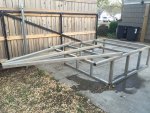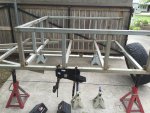PCO6
Adventurer
I’ve made a bit of progress in the last week or so. Picking up where I left off, I added a small extension to the rear bumper for it to line up with the running board.

I then welded the slits I cut into the fenders shut. This really firmed them up.


I installed the fender on the left side and this is where things currently stand.


I made a bracket for the propane tank and installed it on the front left running board. It’s based on a couple of turnbuckles which makes it easy to remove the cylinder when needed. I have yet to make the lock which will secure one turnbuckle to the other so they won’t turn. The rubber pad is to elevate the cylinder above the running board (easier on the paint).


I added spot lights to the rear running boards. These will run off of the trailer battery and will be used to light the camp site when needed. There is a large thumbscrew on the underside of the running board which allows me to rotate the light and retighten it.


Other lights are being installed as I go as is the wiring, switches, fuses, etc. Everything seems to require a bracket of some sort to be fabricated.

This shot shows the start of the tongue box. There is a lot more to come in this area so stay tuned.

I then welded the slits I cut into the fenders shut. This really firmed them up.
I installed the fender on the left side and this is where things currently stand.
I made a bracket for the propane tank and installed it on the front left running board. It’s based on a couple of turnbuckles which makes it easy to remove the cylinder when needed. I have yet to make the lock which will secure one turnbuckle to the other so they won’t turn. The rubber pad is to elevate the cylinder above the running board (easier on the paint).
I added spot lights to the rear running boards. These will run off of the trailer battery and will be used to light the camp site when needed. There is a large thumbscrew on the underside of the running board which allows me to rotate the light and retighten it.
Other lights are being installed as I go as is the wiring, switches, fuses, etc. Everything seems to require a bracket of some sort to be fabricated.
This shot shows the start of the tongue box. There is a lot more to come in this area so stay tuned.





